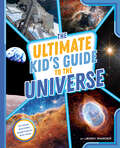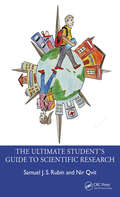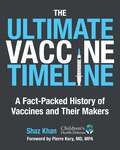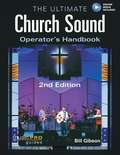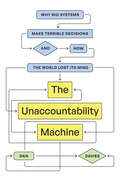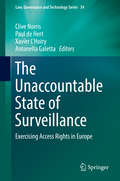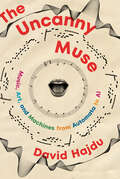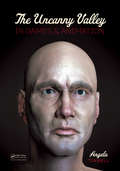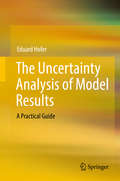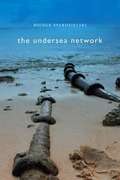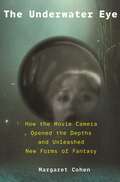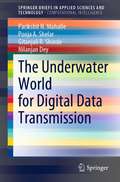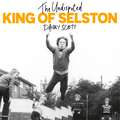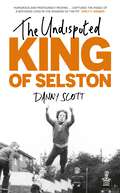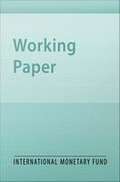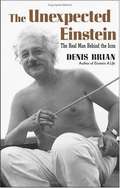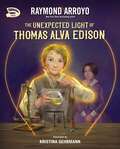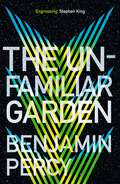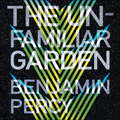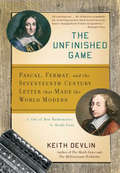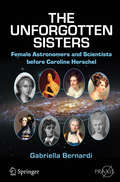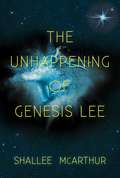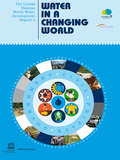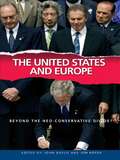- Table View
- List View
The Ultimate Kid's Guide to the Universe: At-Home Activities, Experiments, and More! (The Ultimate Kid's Guide to...)
by Jenny MarderWith stunning photos of outer space and easy at-home experiments, this is the only guide kids need on their journey of learning about all things astronomy: the stars, the planets, the moon, and so much more!Buckle up and let Jenny Marder, a senior writer for NASA, be your guide to the universe! First stop: the moon!A perfect read for kids, just in time for the April 2024 total solar eclipse!
The Ultimate Pet Food Guide: Everything You Need to Know about Feeding Your Dog or Cat
by Liz PalikaThe 2007 pet food recalls followed a multitude of pets getting sick and dying from contaminated food; now pet owners must take charge of what they feed their dogs and cats. With The Ultimate Pet Food Guide, veteran dog trainer, behaviorist, and author Liz Palika focuses on nutritional needs and covers every type of feeding, including controversial raw diets, homemade cooked food, and commercial foods. Palika also addresses introducing new foods; what "human foods” pets shouldn’t eat; free-feeding; responsibility for food safety; where ingredients come from; and red flags in ingredients. Included are over fifty veterinarian- and pet-nutritionist-approved recipes and diets tailored to special-needs pets, such as puppies/kittens and pregnant, older, overweight and/or more sedentary animals.
The Ultimate Student’s Guide to Scientific Research
by Samuel J. Rubin Nir QvitA scientific career is a long and winding journey. Many factors assemble to determine the trajectory and products of scientific inquiry. This book addresses the scientific career path comprehensively, ranging from how to build a strong foundational knowledge and skill base, to training programs, composing winning research proposals and grants, conducting excellent research, writing papers and reports, collaborative research programs, bridging academia and industry, career advancement, and more. Guides where, how, and what to study in undergraduate, post-baccalaureate, graduate, and post-graduate training programs and addresses important crossroads throughout the continuum of training and beyond. Highlights best practices, techniques, and nuances for creating a successful scientific career. Provides critical insights for traversing major milestones and decision-points in a scientific career and serves as a resources for reference throughout stages of advancement. Discusses alternative career opportunities for individuals trained in sciences. Offers students, researchers, and other scientists across all stages of their careers with accessible, engaging, and useful insider tips.
The Ultimate Vaccine Timeline: A Fact-Packed History of Vaccines and Their Makers
by Shaz KhanDive deep into a comprehensive fact-packed history of vaccines that includes information on vaccine manufacturers and their evolution over time. Browse through an extensive series of verifiable and documented facts on vaccines. For well over a century, vaccines have been routinely recommended to billions of people worldwide, mostly children and babies. With an ever-increasing portfolio of vaccines using novel technologies on the global market, it is important now more than ever to consolidate a chronology of facts relating to human vaccination. Considering the current climate of censorship around vaccines, this publication will contribute to an expanded understanding of this important medical intervention. Spanning over fifteen hundred years, this thoroughly researched timeline is an educational tool for any researcher, student, doctor, scientist, parent, or curious human being wishing to gain a broader perspective and insight into the complex and vast landscape of human vaccination. From smallpox to shingles; tetanus to tuberculosis; hepatitis B to HPV, discover when, where, and by whom these vaccines were invented and marketed. Including a historical timeline of pharmaceutical company beginnings, mergers and acquisitions since the seventeenth century, this illustrated reference book shines a light on the controversial subject of vaccines and their makers.
The Ultimate: Church Sound Operator's Handbook
by Bill GibsonThis important second edition of The Ultimate Church Sound Operator's Handbook is written to specifically address the concerns and needs of the sound person who serves ministries and churches. The modern church uses many of the same presentation tools that have become common in television, movies, and concerts, placing a unique set of technical expectations on its eager, willing, and primarily volunteer force. This updated handbook blends the relational and technical aspects of church sound in a straightforward and easy-to-understand manner, providing a leg-up to volunteer and staff church sound operators. The Ultimate Church Sound Operator's Handbook will help church sound operators gain the knowledge they need to faithfully serve their church membership, leaders, and musicians. The book includes access to dozens of video and audio examples online to further help clarify and explain the techniques being discussed.
The Unaccountability Machine: Why Big Systems Make Terrible Decisions—and How the World Lost Its Mind
by Dan DaviesLonglisted for the 2024 Financial Times Book of the Year. How life and the economy became a black box—a collection of systems no one understands, producing outcomes no one likes. Passengers get bumped from flights. Phone menus disconnect. Automated financial trades produce market collapse. Of all the challenges in modern life, some of the most vexing come from our relationships with automation: a large system does us wrong, and there’s nothing we can do about it. The problem, economist Dan Davies shows, is accountability sinks: systems in which decisions are delegated to a complex rule book or set of standard procedures, making it impossible to identify the source of mistakes when they happen. In our increasingly unhuman world—lives dominated by algorithms, artificial intelligence, and large organizations—these accountability sinks produce more than just aggravation. They make life and economy unknowable—a black box for no reason. In The Unaccountability Machine, Davies lays bare how markets, institutions, and even governments systematically generate outcomes that no one—not even those involved in making them—seems to want. Since the earliest days of the computer age, theorists have foreseen the dangers of complex systems without personal accountability. In response, British business scholar Stafford Beer developed an accountability-first approach to management called “cybernetics,” which might have taken off had his biggest client (the Chilean government) not fallen to a bloody coup in 1973. With his signature blend of economic and journalistic rigor, Davies examines what’s gone wrong since Beer, including what might have been had the world embraced cybernetics when it had the chance. The Unaccountability Machine is a revelatory and resonant account of how modern life became predisposed to dysfunction.
The Unaccountable State of Surveillance
by Paul De Hert Clive Norris Xavier L’hoiry Antonella GalettaThis book examines the ability of citizens across ten European countries to exercise their democratic rights to access their personal data. It presents a socio-legal research project, with the researchers acting as citizens, or data subjects, and using ethnographic data collection methods. The research presented here evidences a myriad of strategies and discourses employed by a range of public and private sector organizations as they obstruct and restrict citizens' attempts to exercise their informational rights. The book also provides an up-to-date legal analysis of legal frameworks across Europe concerning access rights and makes several policy recommendations in the area of informational rights. It provides a unique and unparalleled study of the law in action which uncovered the obstacles that citizens encounter if they try to find out what personal data public and private sector organisations collect and store about them, how they process it, and with whom they share it. These are simple questions to ask, and the right to do so is enshrined in law, but getting answers to these questions was met by a raft of strategies which effectively denied citizens their rights. The book documents in rich ethnographic detail the manner in which these discourses of denial played out in the ten countries involved, and explores in depth the implications for policy and regulatory reform.
The Uncanny Muse: Music, Art, and Machines from Automata to AI
by David HajduAn acclaimed critic, journalist, and songwriter-musician tells the story of art’s relation to machines, from the Baroque period to the age of AI. What does it mean to be human in a world where machines, too, can be artists? The Uncanny Muse explores the history of automation in the arts and delves into one of the most momentous and controversial aspects of AI: artificial creativity. The adoption of technology and machinery has long transformed the world, but as the potential for artificial intelligence expands, David Hajdu examines the new, increasingly urgent questions about technology’s role in culture. From the life-size mechanical doll that made headlines in Victorian London to the doll’s modern AI–pop star counterpart, Hajdu traces the fascinating, varied ways in which inventors and artists have sought to emulate mental processes and mechanize creative production. For decades, machines and artists have engaged in expressing the human condition—along with the condition of living with machines—through player pianos, broadcasting technology, electric organs, digital movie effects, synthesizers, and motion capture. By communicating and informing human knowledge, the machines have exerted considerable influence on the history of art—and often more influence than humans have been willing to recognize. As Hajdu proclaims: “before machine learning, there was machine teaching.” With thoughtful, wide-ranging, and surprising turns from Berry Gordy and George Harrison to Andy Warhol and Stevie Wonder, David Hajdu takes a novel and contrarian approach: he sees how machines through the ages have enabled creativity, not stifled it—and The Uncanny Muse sees no reason why this shouldn’t be the case with AI today.
The Uncanny Valley in Games and Animation
by Angela TinwellAdvances in technology have enabled animators and video game designers to design increasingly realistic, human-like characters in animation and games. Although it was intended that this increased realism would allow viewers to appreciate the emotional state of characters, research has shown that audiences often have a negative reaction as the human
The Uncertainty Analysis of Model Results: A Practical Guide
by Eduard HoferThis book is a practical guide to the uncertainty analysis of computer model applications. Used in many areas, such as engineering, ecology and economics, computer models are subject to various uncertainties at the level of model formulations, parameter values and input data. Naturally, it would be advantageous to know the combined effect of these uncertainties on the model results as well as whether the state of knowledge should be improved in order to reduce the uncertainty of the results most effectively. The book supports decision-makers, model developers and users in their argumentation for an uncertainty analysis and assists them in the interpretation of the analysis results.
The Undersea Network
by Nicole StarosielskiIn our "wireless" world it is easy to take the importance of the undersea cable systems for granted, but the stakes of their successful operation are huge, as they are responsible for carrying almost all transoceanic Internet traffic. In The Undersea Network Nicole Starosielski follows these cables from the ocean depths to their landing zones on the sandy beaches of the South Pacific, bringing them to the surface of media scholarship and making visible the materiality of the wired network. In doing so, she charts the cable network's cultural, historical, geographic and environmental dimensions. Starosielski argues that the environments the cables occupy are historical and political realms, where the network and the connections it enables are made possible by the deliberate negotiation and manipulation of technology, culture, politics and geography. Accompanying the book is an interactive digital mapping project, where readers can trace cable routes, view photographs and archival materials, and read stories about the island cable hubs.
The Underwater Eye: How the Movie Camera Opened the Depths and Unleashed New Realms of Fantasy
by Margaret CohenA rich history of underwater filmmaking and how it has profoundly influenced the aesthetics of movies and public perception of the oceansIn The Underwater Eye, Margaret Cohen tells the fascinating story of how the development of modern diving equipment and movie camera technology has allowed documentary and narrative filmmakers to take human vision into the depths, creating new imagery of the seas and the underwater realm, and expanding the scope of popular imagination. Innovating on the most challenging film set on earth, filmmakers have tapped the emotional power of the underwater environment to forge new visions of horror, tragedy, adventure, beauty, and surrealism, entertaining the public and shaping its perception of ocean reality.Examining works by filmmakers ranging from J. E. Williamson, inventor of the first undersea film technology in 1914, to Wes Anderson, who filmed the underwater scenes of his 2004 The Life Aquatic with Steve Zissou entirely in a pool, The Underwater Eye traces how the radically alien qualities of underwater optics have shaped liquid fantasies for more than a century. Richly illustrated, the book explores documentaries by Jacques Cousteau, Louis Malle, and Hans Hass, art films by Man Ray and Jean Vigo, and popular movies and television shows such as 20,000 Leagues Under the Sea, Creature from the Black Lagoon, Sea Hunt, the Bond films, Jaws, The Abyss, and Titanic. In exploring the cultural impact of underwater filmmaking, the book also asks compelling questions about the role film plays in engaging the public with the remote ocean, a frontline of climate change.
The Underwater World for Digital Data Transmission (SpringerBriefs in Applied Sciences and Technology)
by Nilanjan Dey Parikshit N. Mahalle Gitanjali R. Shinde Pooja A. ShelarThis book covers all small details about Underwater Sensor Networks (UWSN). Researchers can use this book as a prerequisite before starting any research on underwater networks or underwater applications. This book covers the introduction, challenges, different architectural models for UWSN, various attacks on UWSN, underwater applications, and networking layers. The target audience includes professors and students in engineering, and researchers and engineers working on marine applications. In academic level, the book is helpful for students having Networking and Information Security as elective subject and doing projects in Wireless Networks. It is also helpful for spostgraduates and Ph.D. researchers to learn basics of Underwater Sensor Networks.
The Undisputed King of Selston
by Danny Scott'Evocative, beautifully written . . . conjures locations and feelings almost magically.' Jeremy Vine'My brain has made the decision . . . I am going to love this book.' Richard Hawley There was a time when he felt like the undisputed King of Selston.Then again, there were several years when he was convinced that he could talk to animals and had even mastered the power of flight - sailing nightly over the headstocks, slag heaps and doggedly beautiful countryside of an isolated East Midlands mining village.But, deep down, Danny Scott knew that the real King of Selston was and always would be coal. Over the last seven hundred years, coal dust had settled on every inch of Selston. It was in the food he ate, the air he breathed and the words he spoke. It fashioned resilient men like his dad and The Texan; feisty women like his mother, whose right-hook was feared even more than her fondness for house fires.Danny was a clever bugger - dangerously clever, some said - and fiercely proud of Selston, his dad and his mining heritage. Five generations of his family had spent their working lives underground, providing fuel for the Industrial Revolution, the electrical, rail and motoring revolutions. Without it, the modern age wouldn't have been so . . . modern.But as this young boy prepared to follow in his dad's footsteps, things began to change. The Devil became captain of the local darts team. Fortune tellers held seances in the front room of his council house. And that once unassailable King's reign seemed to be coming to an end.For dangerously clever buggers, there was only one option... somewhere else, someone new.Funny, poignant and alive to the unheralded beauty, purpose and camaraderie of a village which finds itself on the wrong side of history, THE UNDISPUTED KING OF SELSTON shines a light onto a forgotten industry and the dark shadows that wormed their way into the families who got left behind.
The Undisputed King of Selston
by Danny Scott'Evocative, beautifully written . . . conjures locations and feelings almost magically.' Jeremy Vine'My brain has made the decision . . . I am going to love this book.' Richard Hawley There was a time when he felt like the undisputed King of Selston.Then again, there were several years when he was convinced that he could talk to animals and had even mastered the power of flight - sailing nightly over the headstocks, slag heaps and doggedly beautiful countryside of an isolated East Midlands mining village.But, deep down, Danny Scott knew that the real King of Selston was and always would be coal. Over the last seven hundred years, coal dust had settled on every inch of Selston. It was in the food he ate, the air he breathed and the words he spoke. It fashioned resilient men like his dad and The Texan; feisty women like his mother, whose right-hook was feared even more than her fondness for house fires.Danny was a clever bugger - dangerously clever, some said - and fiercely proud of Selston, his dad and his mining heritage. Five generations of his family had spent their working lives underground, providing fuel for the Industrial Revolution, the electrical, rail and motoring revolutions. Without it, the modern age wouldn't have been so . . . modern.But as this young boy prepared to follow in his dad's footsteps, things began to change. The Devil became captain of the local darts team. Fortune tellers held seances in the front room of his council house. And that once unassailable King's reign seemed to be coming to an end.For dangerously clever buggers, there was only one option... somewhere else, someone new.Funny, poignant and alive to the unheralded beauty, purpose and camaraderie of a village which finds itself on the wrong side of history, THE UNDISPUTED KING OF SELSTON shines a light onto a forgotten industry and the dark shadows that wormed their way into the families who got left behind.
The Unequal Benefits of Fuel Subsidies: A Review of Evidence for Developing Countries
by Robert Gillingham David Coady Javier Arze del GranadoA report from the International Monetary Fund.
The Unexpected Einstein: The Real Man Behind The Icon
by Denis BrianA fascinating book that exposes the many myths about the great scientist. Acclaimed biographer Denis Brian takes on the many myths surrounding the eccentric genius--that he was a woman hater and plagiarist who stole other scientists' ideas, that he didn't speak until he was four or five--many of which were circulated and published while he was still alive. Featuring never-before published interviews and photos, this entertaining and informative book reveals many unexpected facets of Einstein's life--such as his culinary exploits--as it captures the man behind the myths.
The Unexpected Light of Thomas Alva Edison (Turnabout Tales)
by Raymond ArroyoFrom New York Times bestselling author and news anchor Raymond Arroyo comes the first book in the Turnabout Tales series—a picture book biography of one of America&’s most famous inventors, Thomas Alva Edison, and a story about how a small spark can create a big light.No one thought much of young Thomas Alva Edison. He couldn&’t focus at school and caused trouble around the house. But where others saw a distracted and mischievous boy, his mother saw imagination and curiosity. At only seven years old, Al, as he was called as a young child, was educated by his mother, who oversaw his rigorous at-home education while also allowing him great freedom to explore and dream. Those early years of encouragement and loving guidance formed the man who would apply those valuable lessons as well as his rich imagination to inventing the phonograph, the motion picture camera, the light bulb, and more.In The Unexpected Light of Thomas Alva Edison readers will:meet the larger-than-life personality of Thomas Alva Edisonhear an inspiring tale of an underdog overcoming all the oddslearn about the power of curiosity and imaginationtake a carefully researched and actively told romp through history The Unexpected Light of Thomas Alva Edison includes:an annotated list of resources and suggested readingrealistic illustrations by artist Kristina Gehrmannan author&’s note by Raymond Arroyo, the author of the bestselling The Spider Who Saved Christmas The Turnabout Tales series highlights little-known yet fascinating stories of historical figures who went from underdog to hero, and the adults who inspired them to be true to themselves and do big things that changed the world.
The Unfamiliar Garden: The Comet Cycle Book 2 (The Comet Cycle #2)
by Benjamin PercyFrom award-winning author Benjamin Percy comes the second novel in his grippingly original sci-fi series, The Comet Cycle, in which a passing comet has caused irreversible change to the growth of fungi, spawning a dangerous, invasive species in the Pacific Northwest that threatens to control the lives of humans and animals alike.It began with a comet. They called it Cain, a wandering star that passed by Earth, illuminating the night with a swampy green light and twinning the sky by day with two suns. A year later, Earth spun through the debris field the comet left behind. Suddenly, hundreds of thousands of meteors plummeted into the atmosphere, destroying swaths of electrical grids, leaving shores of beaches filled with deceased sea life, and setting acres of land ablaze. It was then, they say, that the sky fell. It was then that Jack lost Mia.Five years after the disappearance of his daughter, Jack has fallen. Once an accomplished professor of botany, he's now a shell of a man who has all but withdrawn from life. Nora, his ex-wife, has thrown herself into her investigative work. Separately, they have each bandaged over the hole Mia left behind.Just as Jack is uncovering a new form of deadly parasitic fungus in his lab, Nora is assigned to investigate the cases of ritualistic murders dotting Seattle. The rituals consist of etchings - crosshatches are carved into bodies and eyes are scooped out of their sockets. The attackers appear to be possessed.It only takes a moment - for a sickness to infect, for a person to be killed, for a child to be lost. When Nora enlists Jack to identify the cause of this string of vicious deaths, Jack is quick to help. Together, they fight to keep their moments - the unexpected laughter, the extraordinary discoveries, the chance that Mia could come back home - but they find that what they're up against defies all logic, and what they have to do to save the world will change every life forever.
The Unfamiliar Garden: The Comet Cycle Book 2 (The Comet Cycle #2)
by Benjamin PercyFrom award-winning author Benjamin Percy comes the second novel in his grippingly original sci-fi series, The Comet Cycle, in which a passing comet has caused irreversible change to the growth of fungi, spawning a dangerous, invasive species in the Pacific Northwest that threatens to control the lives of humans and animals alike.It began with a comet. They called it Cain, a wandering star that passed by Earth, illuminating the night with a swampy green light and twinning the sky by day with two suns. A year later, Earth spun through the debris field the comet left behind. Suddenly, hundreds of thousands of meteors plummeted into the atmosphere, destroying swaths of electrical grids, leaving shores of beaches filled with deceased sea life, and setting acres of land ablaze. It was then, they say, that the sky fell. It was then that Jack lost Mia.Five years after the disappearance of his daughter, Jack has fallen. Once an accomplished professor of botany, he's now a shell of a man who has all but withdrawn from life. Nora, his ex-wife, has thrown herself into her investigative work. Separately, they have each bandaged over the hole Mia left behind.Just as Jack is uncovering a new form of deadly parasitic fungus in his lab, Nora is assigned to investigate the cases of ritualistic murders dotting Seattle. The rituals consist of etchings - crosshatches are carved into bodies and eyes are scooped out of their sockets. The attackers appear to be possessed.It only takes a moment - for a sickness to infect, for a person to be killed, for a child to be lost. When Nora enlists Jack to identify the cause of this string of vicious deaths, Jack is quick to help. Together, they fight to keep their moments - the unexpected laughter, the extraordinary discoveries, the chance that Mia could come back home - but they find that what they're up against defies all logic, and what they have to do to save the world will change every life forever.(P) 2022 HarperCollins Publishers
The Unfinished Game: Pascal, Fermat, and the Seventeenth-Century Letter that Made the World Modern
by Keith DevlinIn the early seventeenth century, the outcome of something as simple as a dice roll was consigned to the realm of unknowable chance. Mathematicians largely agreed that it was impossible to predict the probability of an occurrence. Then, in 1654, Blaise Pascal wrote to Pierre de Fermat explaining that he had discovered how to calculate risk. The two collaborated to develop what is now known as probability theory?a concept that allows us to think rationally about decisions and events. In "The Unfinished Game," Keith Devlin masterfully chronicles Pascal and FermatOCOs mathematical breakthrough, connecting a centuries-old discovery with its remarkable impact on the modern world.
The Unforgotten Sisters
by Gabriella BernardiTakinginspiration from Siv Cedering's poem in the form of a fictional letter fromCaroline Herschel that refers to "my long, lost sisters, forgotten in the booksthat record our science", this book tells the lives of twenty-five femalescientists, with specific attention to astronomers and mathematicians. Each ofthe presented biographies is organized as a kind of "personal file"which sets the biographee's life in its historical context, documents her mainworks, highlights some curious facts, and records citations about her. Theselected figures are among the most representative of this neglected world,including such luminaries as Hypatia of Alexandra, Hildegard of Bingen,Elisabetha Hevelius, and Maria Gaetana Agnesi. They span a period of about 4000years, from En HeduAnna, the Akkadian princess, who was one of the firstrecognized female astronomers, to the dawn of the era of modern astronomy withCaroline Herschel and Mary Somerville. The book will be of interest to allwho wish to learn more about the women from antiquity to the nineteenth centurywho played such key roles in the history of astronomy and science despiteliving and working in largely male-dominated worlds.
The Unhappening of Genesis Lee
by Shallee McarthurWhat would it feel like to never forget? Or to have a memory stolen?Seventeen-year-old Genesis Lee has never forgotten anything. As one of the Mementi-a small group of genetically enhanced humans-Gena remembers everything with the help of her Link bracelets, which preserve them perfectly. But Links can be stolen, and six people have already lost their lives to a memory thief, including Gena's best friend.Anyone could be next. That's why Gena is less than pleased to meet a strange but charming boy named Kalan who claims not only that they have met before, but also that Gena knows who the thief is.The problem is that Gena doesn't remember Kalan, she doesn't remember seeing the thief, and she doesn't know why she's forgetting things-or how much else she might forget. As growing tensions between Mementi and ordinary humans drive the city of Havendale into chaos, Gena and Kalan team up to search for the thief. And as Gena loses more memories, they realize they have to solve the mystery fast...because Gena's life is unhappening around her.
The United Nations World Water Development Report 3: Water in a Changing World (Two Vols.)
by World Water World Water Assessment ProgrammeThe United Nations World Water Development Report, published every three years, is a comprehensive review providing an authoritative picture of the state of the world's freshwater resources. It offers best practices as well as in-depth theoretical analyses to help stimulate ideas and actions for better stewardship in the water sector. It is the only report of its kind, resulting from the collaboration and contributions of the 26 UN agencies, commissions, program, funds, secretariats and conventions that have a significant role in addressing global water concerns. The news media are full of talk of crises - in climate change, energy and food and troubled financial markets. These crises are linked to each other and to water resources management. Unresolved, they may lead to increasing political insecurity and conflict. Water is required to meet our fundamental needs and rising living standards and to sustain our planet‘s fragile ecosystems. Pressures on the resource come from a growing and mobile population, social and cultural change, economic development and technological change. Adding complexity and risk is climate change, with impacts on the resource as well as on the sources of pressure on water. The challenges, though substantial, are not insurmountable. The Report shows how some countries have responded. Progress in providing drinking water is heartening, with the Millennium Development Goal target on track in most regions. But other areas remain unaddressed, and after decades of inaction, the problems in water systems are enormous and will worsen if left unattended. Leaders in the water sector can inform decisions outside their domain and manage water resources to achieve agreed socioeconomic objectives and environmental integrity. Leaders in government, the private sector and civil society determine these objectives and allocate human and financial resources to meet them. Recognizing this responsibility, they must act now! Two volume set: 336
The United States and Europe: Beyond the Neo-Conservative Divide? (Contemporary Security Studies)
by Jon Roper John BaylisA penetrating new examination of the triangular political and cultural relationship between America, Britain, and continental Europe. This relationship is both fraught and dynamic. Post-war reconstruction of Europe brought integration. Creating a ‘United States of Europe’ was a goal shared by many Americans. Yet the contemporary 'War on Terror', has redefined relationships between America, Britain, 'old' and 'new' Europe. For Britain, the Channel seems wider than the Atlantic, although geopolitically it is part of Europe. This book brings together experts from Britain, Europe and America to explore the complexities of contemporary cultural and political relationships, considering the challenges that have been met and those that have to be faced.
